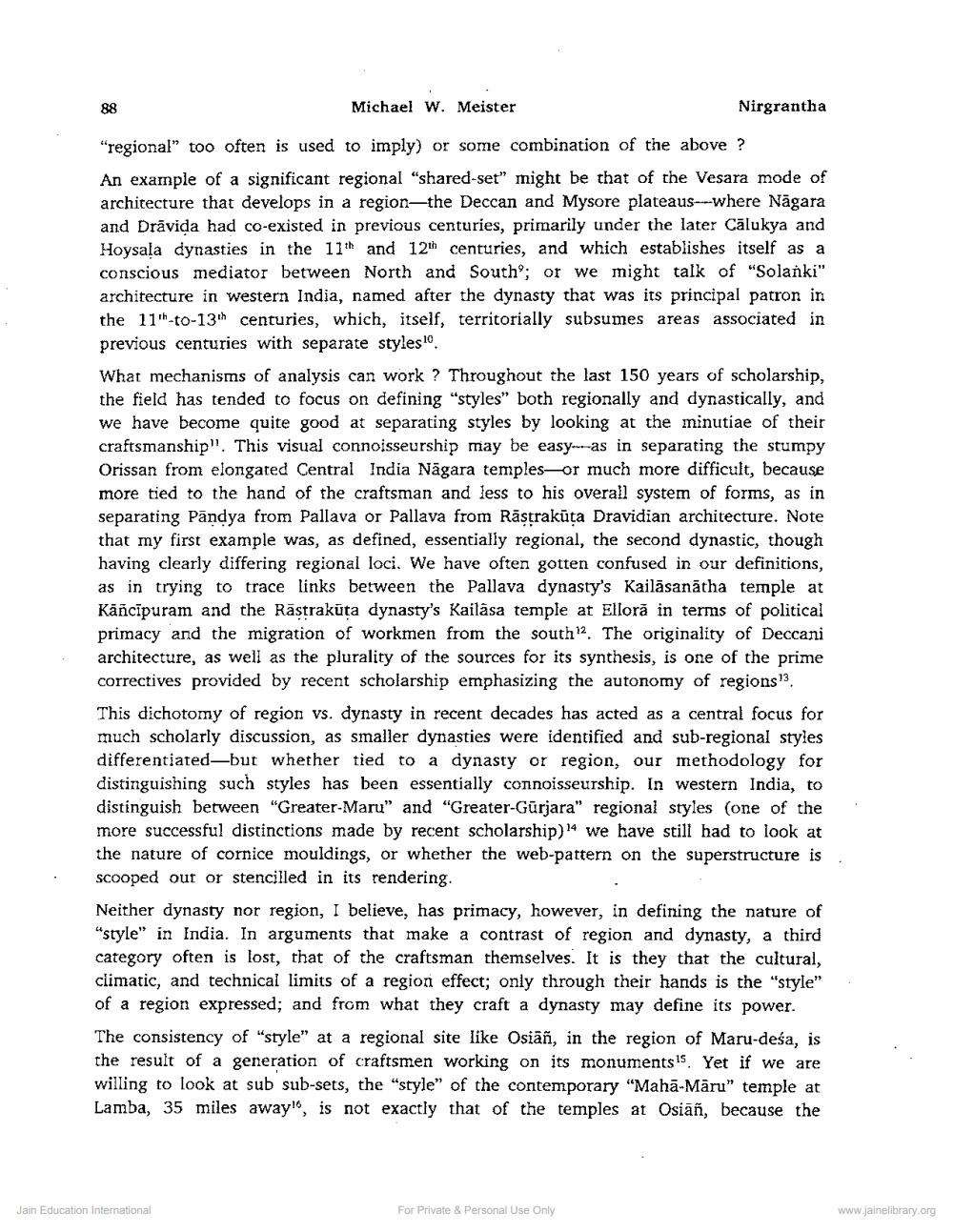Book Title: Regions and Indian Architectures Author(s): Michael W Meister Publisher: Z_Nirgrantha_1_022701.pdf and Nirgrantha_2_022702.pdf and Nirgrantha_3_022703.pdf View full book textPage 2
________________ 88 Michael W. Meister "regional" too often is used to imply) or some combination of the above? An example of a significant regional "shared-set" might be that of the Vesara mode of architecture that develops in a region-the Deccan and Mysore plateaus-where Nagara and Dravida had co-existed in previous centuries, primarily under the later Calukya and Hoysala dynasties in the 11th and 12th centuries, and which establishes itself as a conscious mediator between North and South'; or we might talk of "Solanki" architecture in western India, named after the dynasty that was its principal patron in the 11th-to-13th centuries, which, itself, territorially subsumes areas associated in previous centuries with separate styles1o. Nirgrantha What mechanisms of analysis can work? Throughout the last 150 years of scholarship, the field has tended to focus on defining "styles" both regionally and dynastically, and we have become quite good at separating styles by looking at the minutiae of their craftsmanship". This visual connoisseurship may be easy-as in separating the stumpy Orissan from elongated Central India Nagara temples or much more difficult, because more tied to the hand of the craftsman and less to his overall system of forms, as in separating Pandya from Pallava or Pallava from Rastrakūta Dravidian architecture. Note that my first example was, as defined, essentially regional, the second dynastic, though having clearly differing regional loci. We have often gotten confused in our definitions, as in trying to trace links between the Pallava dynasty's Kailasanatha temple at Kāñcipuram and the Rästrakūta dynasty's Kailasa temple at Ellora in terms of political primacy and the migration of workmen from the south 12. The originality of Deccani architecture, as well as the plurality of the sources for its synthesis, is one of the prime correctives provided by recent scholarship emphasizing the autonomy of regions13 This dichotomy of region vs. dynasty in recent decades has acted as a central focus for much scholarly discussion, as smaller dynasties were identified and sub-regional styles differentiated but whether tied to a dynasty or region, our methodology for distinguishing such styles has been essentially connoisseurship. In western India, to distinguish between "Greater-Maru" and "Greater-Gurjara" regional styles (one of the more successful distinctions made by recent scholarship) we have still had to look at the nature of cornice mouldings, or whether the web-pattern on the superstructure is scooped out or stencilled in its rendering. Neither dynasty nor region, I believe, has primacy, however, in defining the nature of "style" in India. In arguments that make a contrast of region and dynasty, a third category often is lost, that of the craftsman themselves. It is they that the cultural, climatic, and technical limits of a region effect; only through their hands is the "style" of a region expressed; and from what they craft a dynasty may define its power. The consistency of "style" at a regional site like Osiäñ, in the region of Maru-dela, is the result of a generation of craftsmen working on its monuments 15. Yet if we are willing to look at sub sub-sets, the "style" of the contemporary "Mahä-Märu" temple at Lamba, 35 miles away", is not exactly that of the temples at Osiäñ, because the Jain Education International For Private & Personal Use Only www.jainelibrary.orgPage Navigation
1 2 3 4 5 6 7 8
